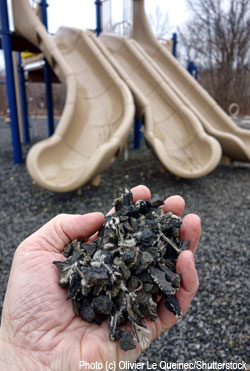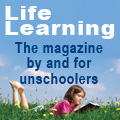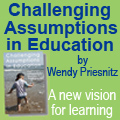Do You Know What Your Child Is Playing On?
An Overview of Playground Surface Materials
By Wendy Priesnitz

Playground surfaces are important. After all, kids can get badly hurt if they fall on concrete or other paved surfaces. And, let’s face it, kids fall a lot, especially when they’re playing on playground equipment or school and community play fields. An estimated eighty percent of injuries on playgrounds are as a result of falls. So it’s a good thing that many playgrounds provide a surface that’s softer than pavement. Unfortunately, it appears not to be such a good thing that some of those surfaces could be providing health effects much worse than a skinned knee or even a broken arm.
Rubber
Rubber mulch chips and rubber mats are manufactured from recycled tires and sold as shock-absorbing materials for playgrounds. The chips are also sold as garden mulch. Since tires are made of vulcanized rubber, the mulch made from them is said by its manufacturers to be virtually indestructible, so it won’t crumble or disintegrate.
However, in some jurisdictions, rubber tires are classified as “hazardous waste” and can’t be disposed of without a permit. That’s because tires contain a variety of toxins, including carcinogens, chronic lung irritants, and endocrine disruptors. Various studies have identified the chemicals found in tires, which are made of forty to sixty percent rubber polymers, carbon black (twenty to thirty-five percent), silicas, process and extender oils (up to twenty-eight percent), vulcanization chemicals and chemical antidegradents, plasticizers and softeners, and heavy metals.
In 2007, Environment and Human Health, Inc. (EHHI) – a non-profit organization composed of doctors, public health professionals, and policy experts – released a report about potentially harmful exposures to recycled tire products used on playgrounds and soccer fields. Informed by studies that found cancer in workers in rubber fabrication and reclamation industries, EHHI undertook an exploratory study with the Connecticut Agricultural Experiment Station to examine what the materials were and whether they out-gassed harmful chemicals into the air or were capable of leaching into ground water.
The four compounds confirmed to be found in the Connecticut Agricultural Experiment Station study were: benzothiazole (skin and eye irritant); butylated hydroxyanisole (carcinogen, endocrine toxicant, immunotoxicant, neurotoxicant, and more); n-hexadecane (severe irritant); and 4-(t-octyl) phenol (corrosive and destructive to mucous membranes). And approximately two dozen other chemicals were found at lower levels.
In a press statement at the time of the study, David Brown, Sc.D., EHHI’s public health toxicologist, said, “Health endpoints of concern are numerous. Some are acute irritation of the lungs, skin, and eyes, and chronic irritation of the lungs, skin, and eyes. However, knowledge is more limited about the effects of semi-volatile chemicals on the kidney, endocrine system, nervous system, cardiovascular system, immune system and development.”
Artificial Turf
Artificial or synthetic turf is manufactured from polymers such as polypropylene or polyethylene. It was developed in the mid-1960s by Monsanto under the name AstroTurf, and has since gained widespread popularity as a replacement for grass. Originally used in stadiums and on athletic fields for college and professional sports teams, it now is also used in municipal parks, golf courses, playgrounds, cruise ships, and airports. There is also a growing residential market for artificial turf.
Artificial turf has some issues, including overheating (as high as two hundred degrees) on hot days. It has also been reported to increase ankle injuries and skin abrasions. It requires the application of harmful disinfectants and sprays to reduce static cling and odors. In the past, many synthetic turf companies used lead paint to make the plastic blades of “grass” green, a practice that is now thought to have been stopped after a series of lawsuits against the industry.
But one of artificial turf’s biggest health drawbacks is that many brands use a finer version of rubber mulch, also made from ground up recycled tires – called “tire crumb” or “crumb rubber” – as in-fill between the blades of “grass” to provide stability, uniformity, and resiliency to the synthetic turf fields. Crumb rubber is a pellet-like substance the size of a cracker crumb. It sheds dust that can easily get into a person’s mouth, nose, shoes, and clothing. Many public health organizations have concerns about the use of tire crumb in artificial turf.
Doctors from New York’s Mt. Sinai Children’s Environmental Health Center have written: “Exposures to chemicals present in crumb rubber at very high levels, typical of animal or occupational studies, are known to cause birth defects, neurologic and developmental deficits, and some can even cause cancer.”
David Brown, Sc.D., EHHI’s public health toxicologist, says, “It is clear the recycled rubber crumbs are not inert, nor is a high temperature or severe solvent extraction needed to release metals, volatile organic compounds, or semi-volatile organic compounds. The Connecticut Agricultural Experiment Station study conclusively demonstrates that the tire crumbs and tire mulch release chemical compounds into the air and ground water. Thus, tire crumbs constitute a chemical exposure for humans and the environment.”
The California-based Center for Environmental Health further points out that children are particularly vulnerable to toxic threats: “Children have increased exposure to toxic chemicals due to the unique way they interact with their environment. Because they are growing and developing, their bodies are also more susceptible than adults’ to chemical exposures.”
Unfortunately, children’s exposure to these chemicals while using artificial turf fields has not been adequately studied. The U.S. Environmental Protection Agency (EPA), in an evaluation of its study of crumb rubber, determined that it was not possible for the agency to reach “comprehensive conclusions without the consideration of additional data.”
According to Dr. Joel Forman, an associate professor of pediatrics and preventive medicine at New York's Mt. Sinai Hospital, these data gaps make it difficult to draw firm conclusions. He says, “None of [the studies] are long term, they rarely involve very young children, and they only look for concentrations of chemicals and compare it to some sort of standard for what’s considered acceptable. That doesn’t really take into account subclinical effects, long-term effects, the developing brain, and developing kids.”
The good news is that, in February 2016, the EPA, the Centers for Disease Control and Prevention/Agency for Toxic Substances and Disease Registry (ATSDR), and the U.S. Consumer Product Safety Commission (CPSC) launched a multi-agency action plan to study key environmental human health questions.
In spite of the proven negative effects of both scrap tire materials and artificial turf on children, studies which have been around for at least a decade, the industry shows research demonstrating no negative health effects from either surfacing treatment. What the industry doesn't note is that this so-called “research” is paid for by the industry! (Interestingly enough, their efforts have given rise to a PR technique called “astroturfing,” which is intended to give the statements or organizations credibility by withholding information about their financial connection.)
Meanwhile, some jurisdictions, like New York City and the Los Angeles Unified School District, have removed crumb rubber from play areas for young children, or are using alternatives in new installations. The Center for Environmental Health recommends that schools, when feasible, replace crumb rubber infill with natural materials such as cork, coconut fibers, and even sand. In spite of these concerns, which have been around for close to ten years and were recently revived by an investigative report by NBC news, the industry claims that research demonstrates no negative health effects from scrap tire materials.
Wood Chips
Aside from the possible health effects, in a 2007 report on the safety of rubber playground chips, California officials found that nearly seventy percent of rubber surfaces weren’t shock-absorbent enough to actually cushion falls, possibly due to lack of maintenance. Wood chips were found, in one study, to do a better job of protecting children from head trauma than surfaces using recycled rubber.
Wood chips are natural and inexpensive; some municipalities have them in abundance due to tree trimming. However, the U.S. Department of Interior (DOI) has determined that ordinary wood chips are not considered an accessible playground surface. In its place, the International Play Equipment Manufacturers Association (IPEMA) prefers Engineered Wood Fiber (EWF). This is wood ground to a fibrous consistency, randomly sized but not typically over two inches in length. The fibers knit together to provide a surface springy enough to cushion falls, yet firm enough for wheelchairs, and they tend not to cause splinters. Besides meeting ASTM International safety and accessibility standards, EWF is a totally natural product and is not chemically treated.
Sand and Pea Gravel
Grass is still found in some playgrounds. (And there can be problems with grass, too, if herbicides are used.) However, research has found that impactable, absorbant materials, such as sand or pea gravel, provide better protection than grassy surfaces, with one study finding that risk of injury is reduced by 1.7 times when playgrounds are surfaced with sand rather than grass.
Researchers at The Hospital for Sick Children and York University, both in Toronto, have found that using granite sand as playground surfacing reduced the risk of arm fractures, compared to wood chip surfaces. The study published in 2009 in the open-access journal PLoS Medicine, showed the risk of an arm fracture from a fall off playground equipment was almost five times higher on a wood chip surface compared to sand. Risks of other types of injuries were also higher on wood-chip surfaces.
However, playground designers don’t favor sand because it hardens quickly, gets tracked into schools on students’ shoes, and attracts animals who use the play area like a litter box.
An alternative is pea gravel – smooth, round, pea-sized stones that slide over each other’s surfaces to absorb shock. It is relatively inexpensive, clean, doesn’t track into buildings (especially important for school playgrounds), and drains well.
Whatever type of loose fill is used on a playground, it should be present in sufficient quantities. The Canadian Standards Council, which produces a nationally recognized standard for playground safety, stipulates the material be used at a depth of at least 15 cm (6 in) for preschool equipment and 30 cm (12 in) for full-sized equipment. That means regular maintenance is almost as important as the choice of material.
While we cannot and, I think, should not inhibit our children’s free outdoor play by being fearful – or, worse, instilling fear in them – we can ensure that the playgrounds they use are as safe as possible.
Helping Kids Play Safely
- Avoid tire crumb playgrounds in favor of wood chip or grass sites.
- Use well-maintained playgrounds, because any loose surface material can become scattered and thin, exposing your child to a hardened, compressed surface.
- If you and your kids can’t avoid using synthetic turf fields, remove the crumb rubber pellets from clothing, bodies, and equipment after playing.
- Do not use synthetic turf on extremely hot days.
- Don’t let kids lie down or eat on a surface that uses recycled tire rubber.
- Teach your children the importance of frequent hand washing after playing.
- Lobby for the use of wood chips, EWF, pea gravel, or sand surfaces rather than artificial turf or recycled rubber.
- Reduce the risk of falling by having children use age-appropriate equipment.
- Avoid dressing children in scarves and clothing with drawstrings or cords that could catch on playground equipment.
- Supervise very young children on playground equipment.
Wendy Priesnitz is Child's Play Magazine's editor. She is a journalist with forty years of experience, the author of twelve books about green living, natural parenting, and learning without school, and the mother of two adult daughters.
Copyright © Life Media
Privacy Policy
 



|

